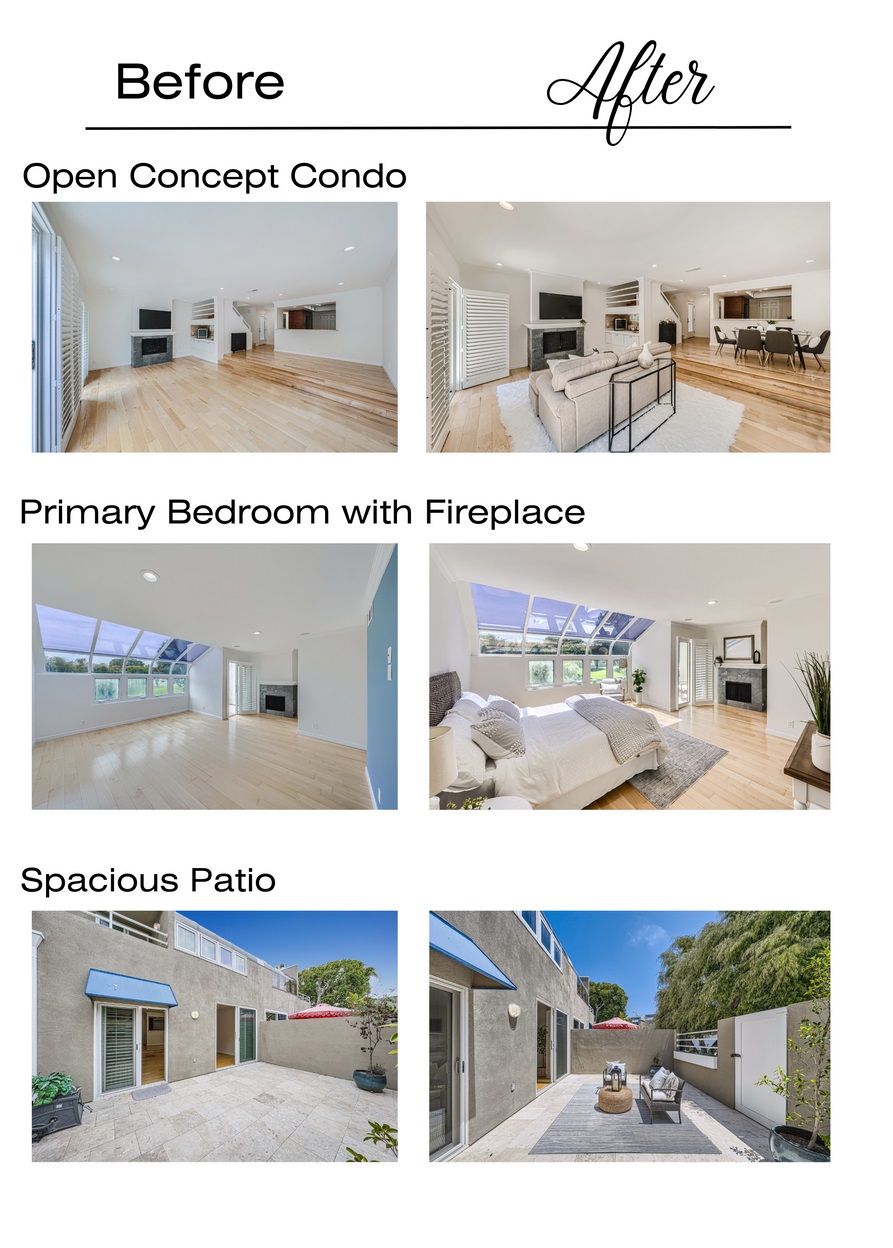
12th Annual FREE Pumpkin Patch at the Beach

 I am hosting our 12th Annual FREE PUMPKIN PATCH at the Beach on Saturday, October 19, 2024 from 10AM to 2PM.
I am hosting our 12th Annual FREE PUMPKIN PATCH at the Beach on Saturday, October 19, 2024 from 10AM to 2PM.
The event is going to be at my oceanfront office: 1720 Pacific Coast Highway, Huntington Beach, CA.
Every child gets a Free Pumpkin + Face painters, balloon artists, and a chance to win $100 by Guessing the Weight of the Giant Pumpkin (winner keeps pumpkin).
Share with family, friends, & Social Media: www.HBpumpkinPatch24.com
Questions: Scot Campbell, Realtor 714-336-0394 Scot@Campbellrealtors.com
SPECIAL REPORT: Exchanging With a Related Party

 Source: Article was provided by First American Exchange Company, LLC, a Qualified Intermediary, is not a financial or real estate broker, agent or salesperson, and is precluded from giving financial, real estate, tax or legal advice. Consult with your financial, real estate, tax or legal advisor about your specific circumstances. First American Exchange Company, LLC makes no express or implied warranty respecting the information presented and assumes no responsibility for errors or omissions.
Source: Article was provided by First American Exchange Company, LLC, a Qualified Intermediary, is not a financial or real estate broker, agent or salesperson, and is precluded from giving financial, real estate, tax or legal advice. Consult with your financial, real estate, tax or legal advisor about your specific circumstances. First American Exchange Company, LLC makes no express or implied warranty respecting the information presented and assumes no responsibility for errors or omissions.
When considering purchasing from or selling to an individual or entity that is considered a “related party,” a taxpayer must take certain factors into consideration to have a successful exchange. In some cases an exchange may not work, or there may be a mandatory two-year holding period required for the replacement property. This article covers the basics of related-party exchanges, explaining why these rules exist, and how a taxpayer should approach a related-party exchange.
What is a related-party exchange?
A related-party exchange occurs when a taxpayer buys or sells real property from or to an individual or entity that is considered related to them under Sections 267(b) and 707(b) of the Internal Revenue Code. Related parties include a spouse, sibling, ancestors, and lineal descendants. In addition, if someone owns more than a 50% interest in a corporation or partnership, that corporation or partnership is considered a related party. The full definition of “related party” is located in the code sections referenced above.
Initially, related parties could exchange properties without any limitations. In 1989, Section 1031 of the Internal Revenue Code was revised to limit related-party exchanges. The reason for the change was to discourage “basis shifting,” where a taxpayer with a low basis trades properties with a related taxpayer with a high basis. This is done to eliminate or reduce capital gains taxes on the sale of the property that originally had a low basis (and now in the hands of the related party has a high basis). For example, X has a property worth $1M with a basis of $100,000. He wants to sell but wants to avoid paying taxes on the $900,000 of gain. Y, his son, has a property worth $1M with a much higher basis of $950,000. X and Y exchange properties, each carrying over their basis from the property they exchanged. Y, now the owner of X’s former property, arranges with X to sell the property to a third party, triggering capital gains on $50,000. Taxes are only paid on that amount, instead of on the $900,000 that X would have realized had he not exchanged with Y. This scenario illustrates the core concepts of basis shifting.
Can a taxpayer exchange with a related party?
The answer to this question depends on whether the taxpayer is swapping properties with the related party, selling to them only, or purchasing from the related party.
Swapping with a related party
When swapping with a related party, such that a taxpayer relinquishes property to the related party and acquires replacement property from the same related party, an exchange is possible provided that both parties hold their respective replacement properties for a minimum of two years after the date of the last transfer that was part of the exchange. If either party transfers their property before that date, both exchanges will be disqualified, with both taxpayers obligated to pay tax on their gain. That tax will be payable for the tax year in which the sale of the property acquired in the exchange occurs.
In the past, some taxpayers have tried to avoid these restrictions by setting up their exchange with a related party using an intermediary. The theory was that because each taxpayer is technically exchanging with the intermediary, no related-party issues should arise. However, there have been several cases and rulings stating that using an intermediary does not exempt the taxpayer from the related party restrictions. This is based on the statement contained in IRC Section 1031(f)(4) that the benefits of Section 1031 do not apply “to any exchange which is part of a transaction (or series of transactions) structured to avoid the purposes of this subsection.”
There are a few exceptions to the rule, which are discussed below.
Selling to a related party
Generally, the view when selling to a related party in an exchange using an intermediary is that a taxpayer may proceed to exchange and acquire property from an unrelated party. Since the taxpayer is shifting its low basis to a property owned by an unrelated party, there is no cashing out of their investment in the same way as described above in a related-party swap. However, a taxpayer should always discuss the sale of property to a related party with a tax advisor, as there are other considerations to keep in mind – such as making sure the transaction is arm’s length.
Buying from a related party
When purchasing from a related party and selling to an unrelated party in an exchange, there are very limited instances in which a taxpayer can successfully defer gain. In many cases, the IRS and courts have disqualified such exchanges because of the potential for basis shifting. The basis shifting can occur and ruin the exchange even when it is unintentional.
However, there has been a Revenue Ruling and some cases indicating that a taxpayer may buy from a related party provided that the related party also completes an exchange (or is otherwise afforded non-recognition treatment and is not cashing out on their sale).
Exceptions
As discussed above, the related-party rules impose a two-year holding period for properties acquired in an exchange between related parties, and in some cases prohibit exchanging with a related party. Section 1031(f)(2) contains three exceptions to the limits imposed by 1031(f)(1). First, the parties may dispose of their properties during the two-year holding period upon the death of either the taxpayer or the related party. Second, if either party’s property is subject to an involuntary conversion prior to the end of the two-year period, that disposition will not trigger a taxable event for the parties. Finally, trading with a related party will not disqualify the exchange when “it is established to the satisfaction of the Secretary that neither the exchange nor such disposition had as one of its principal purposes the avoidance of Federal income tax.”
This last exception (the “non-tax avoidance exception”) has been used to allow related parties with undivided interests in different properties to trade them so that each taxpayer holds either a 100% interest in one of the properties or a larger undivided interest in one of the properties. For example, if two related parties each owns a 50% tenant-in-common interest in two properties, they can trade their interests such that each taxpayer owns a 100% interest in one of the properties.
As mentioned above, the non-tax avoidance exception has also been applied to exchanges where the taxpayer is acquiring replacement property from a related party who is also doing an exchange. Finally, the non-tax avoidance exception has been applied to transactions where the taxpayer could prove that there was no intention of or resultant basis shifting or other avoidance of tax, but such taxpayer-friendly rulings have been very limited.
Conclusion
Given the potential roadblocks to completing a successful exchange when purchasing from or selling to a related party, it is essential that a taxpayer planning on doing so always discusses their transaction and goals with their tax advisor. This way they can ensure they are following any applicable rules to avoid disqualification of their 1031 exchange and a resultant tax penalty, even in a situation where the intention is not basis-shifting.
First American Exchange Company, LLC, a Qualified Intermediary, is not a financial or real estate broker, agent or salesperson, and is precluded from giving financial, real estate, tax or legal advice. Consult with your financial, real estate, tax or legal advisor about your specific circumstances. First American Exchange Company, LLC makes no express or implied warranty respecting the information presented and assumes no responsibility for errors or omissions. First American, the eagle logo, and First American Exchange Company are registered trademarks or trademarks of First American Financial Corporation and/or its affiliates.
Here are 50 real estate terms you should know

 by Scot Campbell | Broker | Realtor | 714-336-0394 | Scot@CampbellRealtors.com
by Scot Campbell | Broker | Realtor | 714-336-0394 | Scot@CampbellRealtors.com
Whether a home buyer, home seller, investor, or Realtor, there are some words and phrases that frequently crop up. With the help of Inman News and 30+ years in the industry, I chose 50 terms to create an easy-to-use glossary you’ll return to again and again.
A
Accessory dwelling unit (ADU)
Sometimes referred to as a “mother-in-law suite,” an accessory dwelling unit is a second residential area on a homeowner’s property. The accessory unit is typically either detached from the main home as a separate structure, or walled off from the home for the privacy of the second residents. These units are often installed on a property to house family members close by, or to rent out to another family altogether. Local laws and zoning ordinances often restrict the size and other features of these structures, and sometimes do not allow them at all.
Active Under Contract
This means the seller of the home has received an offer from a potential buyer. However, there are certain contingencies that need to be met before the sale can be finalized. A purchase contract may include contingencies — such as a buyer’s contingency for a property inspection and negotiating any necessary repairs with the seller before closing. If any of these contingencies are not met, the contract will be null and void, and there may or may not be penalties assessed. Most of the time, the contingencies within a contract can be worked through without any issues. But there are times when a buyer will back out of a deal because an agreement cannot be reached. Once all of the contingencies have been removed and the active contingent stage is completed, the property will show a “pending” status. If a buyer is very interested in an “active contingent” home, it is a good idea to write a Back-Up Offer. If the buyer who is in escrow cannot perform, the seller will often “jump” straight to the Back Up Buyer.
Addendum
An addendum is an additional document that gets added to the purchase and sale agreement. The document will include any additional information or requests that the buyer did not put into the original purchase and sale agreement. The language in the addendum has the ability to override the original terms of the agreement. For this reason, any addendums that are attached can be very powerful. Adding an addendum to a contract is often preferred to other methods, such as striking out clauses within the contract.
Adjustable rate mortgage
An adjustable-rate mortgage is a mortgage that does not have a fixed interest rate. The rate changes throughout the lifetime of a loan based on the movements in an index rate. This type of mortgage usually offers a lower initial interest rate compared to fixed-rate loans.
Amortization
Amortization is the schedule of a homeowner’s monthly mortgage loan payments. An amortization schedule shows you how much of their monthly mortgage payment goes to interest and how much to principal. Near the beginning of a loan’s term, most of the monthly payment will be applied to the interest and a smaller portion to the principal balance. As the homeowner continues to make payments, the monthly amount going toward interest will decrease and a greater share of the payment will be put towards the mortgage balance.
Appraisal
An appraisal is the estimation of a home’s current market value. A licensed appraiser completes this estimation, which is calculated by comparing the recent sales of homes in the area as to the property that is being appraised. This is required by mortgage lenders to be sure that the money they are lending to a new homeowner or a current homeowner is a fair amount for the home. The lenders want to be sure that the buyers are not overpaying for the property. This is to protect the lender. If the borrower stops making payments on the home and the lender needs to sell it, the lender wants to be sure it can recuperate the amount owed on the loan.
‘As is’ or ‘where is’
When a property is sold “as is” or “where is,” it means the sellers don’t want to perform any repairs on the home prior to closing. There’s no guarantee from the seller that everything is in working condition, and thus, a buyer who purchases a home “as is” is responsible for fixing any problems the home may have or any repairs that may be needed. Bank Owned Homes and Probate Sales are often sold “As-Is”.
B
Back-Up Offer
While a home is “Active Under Contract” the buyer is in the process of doing inspections, reviewing the preliminary title report, HOA documents, disclosures, and attempting to obtain a loan approval. Another buyer who is highly interested in the property may benefit by submitting a “Back Up Offer”. If the buyer who is in escrow cannot perform, the seller will often “jump” straight to the Back Up Buyer.
Basis Points
The term “Basis Point” is a term from the lending industry. One hundred basis points is equal to one percent. One might hear a lender say that mortgage rates dropped 50 basis points… this means that mortgage rates dropped one half of one percent (ie: from 7% down to 6.5%).
Blind offer
Though not typically advisable, some homebuyers will purchase a property sight unseen. Known as a blind offer, these types of deals are more popular amongst buyers seeking to flip homes as a business venture.
Broker price opinion
When preparing a home to list on the market, a real estate professional will often give a broker price opinion on how much the home should sell for. This opinion is usually based on a market analysis of similar homes and can incorporate a more detailed evaluation of the home’s interior condition. A broker price opinion is most frequently used to inform the home’s eventual list price. BPOs are sometimes ordered by banking asset managers when borrowers default on their mortgage payments. BPOs are more affordable than a full appraisal and are commonly used to estimate property value for foreclosures and short sales.
Buy Down
When a seller wants to provide an incentive or “increase the buyer pool” for their home, they may elect to offer a “Buy Down” of the buyers mortgage rate. Some Buy Downs are 2-1 (two percent lower mortgage rate first year of loan, one percent lower mortgage rate the second year of loan). Similarly, it is possible in some market segments to get a 3-2-1 Buy Down. The seller can also reduce the mortgage for the life of the loan by paying Loan Points for the buyer; however, the reduction in rate is much smaller than with a buy down.
Buyer concessions
Concessions are benefits or discounted offers by the buyer to help sell a home and close a deal. Usually specified during negotiations, concessions can include covering the cost of new appliances in a home, moving expenses and any repairs needed. Concessions can impact the selling price of a home, so oftentimes, appraisers take concessions into consideration when evaluating the home and comparable properties in the area.
C
Cancellation of contract
According to the terms of the initial contract, the buyer or seller may have opportunities to cancel it. Cancelation can happen when a buyer fails to secure financing for the purchase, or when an inspection reveals flaws that the seller is unwilling to address. Typically the buyer has more opportunities to back out than the seller, but may lose their earnest money or option fee in the process.
Cancelled Status in the Realtor MLS
If a homeowner decides they no longer want to sell their home, sometimes the listing agent and the seller elect to “cancel the MLS listing”. When this happens, the home will show up as “Cancelled” status in the Realtor MLS.
Close of Escrow
In Southern California we say “Escrow has Closed” when we get confirmation that the grant deed was recorded by the County Recorder’s Office.
Comparative market analysis
A comparative market analysis (CMA) is used by real estate agents to estimate the value of a property by comparing and evaluating the property to similar ones that have recently sold in the same area. CMA is one of the cornerstones of pricing a property well, or making a competitive offer. Agents should familiarize themselves with the various search parameters that can help find similar properties, from number of bedrooms and bathrooms to the home’s square footage, age and more.
Contingency
A contingency is a clause in a formal real estate contract that states there are certain conditions that must be met, by either the buyer or the seller, in order to continue to the next step in the contract. There are contingencies in almost every real estate contract. They are there to protect the buyer and the seller. If the contingencies are not met, there might be a breach in the contract, and the transaction could fail to close. One of the most important types is a financing contingency. This type of contingency ensures the buyer is able to secure the needed mortgage within a reasonable time period before closing. Contingencies can also be tied to the results of the home inspection, or the timely sale of the buyer’s current home.
Counter offer
When a buyer’s offer doesn’t live up to a seller’s expectations, the seller can submit a counteroffer. This typically amounts to a rejection of the original offer. Sellers who do this put the original offer at risk, and give the buyer a chance to walk away without going under contract. If the buyer accepts a counteroffer and makes the up-front payments required, both parties are under contract.
D
Deed
When you are transferring the ownership of a home, whether through a home purchase or an inheritance, you will need a Grant Deed in the State of California. This is the legal document that transfers the property ownership from one person to another. The Grant Deed to a home is also known as a title and is the written proof of who owns the home. The new homebuyer will receive a copy and the original copy recorded at the county and copies will be available from title companies.
Default
A “default” occurs when a borrower does not make his or her mortgage loan payment and falls behind. When this happens, he or she risks the home heading into the foreclosure process. Usually, the foreclosure process is started within thirty days after the due date is not met. When a mortgage loan goes into default, the agency that is the loan holder has the option of taking over the property.
Depreciation
Depreciation is defined as a decrease in the value of a property over time. While the main driver of depreciation is usually a sustained downturn in home prices, other factors can also play a role, such as the amount of wear and tear on the home and any changes in the neighborhood. At the end of the day, the home is only as valuable as the price sellers will pay for when the homeowner is ready to sell.
Disclosures
In California, there are many Disclosure Forms used to complete the disclosure process. Transfer Disclosure Statement, Seller Property Questionaire, Natural Hazards Disclosure Report, Structural Pest Control Report, HOA Packet, and many others. The seller is expected to disclose defects they are aware of and other information if it is deemed to affect the use, value, or desirability of the property now or in the future. Lack of disclosure is the primary reason for litigation between buyers & sellers after close of escrow.
Down payment
A down payment is the amount of money that a buyer has saved to help fund the purchase of a home. This amount is usually given as a percentage of the total of the home’s purchase price. For example, a common down payment amount is 20 percent, which means the buyer will be paying 20 percent of the total purchase price upfront. The remainder of the purchase price over and above the down payment is typically covered through a mortgage loan.
E
Earnest money deposit (EMD)
The earnest money deposit is a portion of the sales price that is typically held in escrow until buyers complete a purchase transaction or cancel a contract. Depending on the reason and timing for backing out of a contract, the buyer may lose this earnest money amount, and could also be the target of a legal dispute. Buyers write contingencies into their offers to maintain their right to back out of the deal while protecting their earnest money. In California it is customary to remove contingencies “in writing”… the buyer’s EMD is not at risk in most cases until the buyer has removed all contingencies in writing.
Easement
An easement is defined as someone’s right to use a piece of land — someone who is not the owner of the land. There are many easements that can affect the value of land, but oftentimes there is nothing a homeowner can do about them. An easement is usually put into place to serve a purpose and is limited to this particular type of use only — such as for utility companies to access underground infrastructure. Easements are why it is important for homebuyers to review the Preliminary Title Report. The utility and any other recorded easements will show up on the Preliminary Title Report.
Encroachment
When you own a home or you are preparing to purchase a home, you do not want anyone to have their personal property on what is supposed to be your property. But boundary issues happen, and they can be ugly. There is a term for this battle of land: “encroachment.” An encroachment happens when a fence or another piece of your neighbor’s property crosses the property lines. Other examples of encroachments could involve trees, parts of a building, fencing or any other fixtures located on both pieces of property.
Equity
Equity is the market value of real property, minus the amount of any liens — including mortgages — that may exist against the property. For a client who has $280,000 in mortgage debt against a home that could sell for $800,000 on the market, their equity in the home is generally the difference between the two amounts, or $520,000.
Escalation clause
An escalation clause, oftentimes referred to as an escalator, is a clause in a real estate contract that lets homebuyers increase their offer by a pre-determined amount over other offers in case the seller receives another offer at a higher price point. Escalation clauses are typically reserved for when a buyer is confident there will be multiple offers or if the buyer expects to pay an increased price for the property.
Escrow
Escrow is a term that homebuyers, sellers and real estate agents should be very familiar with and have a complete understanding of before buying or selling a home. Escrow is a term that refers to a third party hired to handle the property transaction, the exchange of money and any related documents. Escrow comes into play once both parties have reached a mutual agreement or offer. The escrow officer handles the transfer of the buyer’s loan documents and property taxes, as well as working with the lender for the buyer to be sure that the title does not have any liens on it before the transfer of ownership is completed. “Being in escrow” is a legal procedure that is used when real property requires a transfer of title. An escrow account is opened by the listing agent when the sellers of the property and the buyers of the property have come to an agreement on the selling price, the terms and any other contingencies that they may have and are ready to close the deal. The parties on both sides will sign all appropriate documents, and then escrow is ready to be opened.
F
Fiduciary
“Fiduciary” is a term that refers to a legal relationship that is confidential between two parties. This relationship gives one party the right to act and make important decisions for the other party. In the world of real estate, the real estate agent and his or her clients (buyers or sellers) participate in a fiduciary relationship. The two parties enter into a signed agreement in which the client puts trust in the real estate agent to work with their best interests in mind. The duties that are required in a fiduciary relationship will vary from state to state, but all require confidentiality. The real estate agent’s responsibility is to protect the privacy of the client and to keep all of the client’s information confidential. Throughout the entire process, including negotiations and closing, the real estate agent should keep all of a client’s information (personal and financial) private.
Fixed-rate mortgage
The vast majority of mortgages in recent years come with a fixed interest rate. This means the rate is locked in for the full duration of the loan — usually a 15-year or 30-year period. Because the rate cannot change, the portion of the mortgage payment that goes toward principal and interest is also fixed. Making this fixed monthly payment in full over the lifetime of the loan results in a complete repayment of the loan balance, and no further money is owed.
For Sale By Owner (FSBO)
One way to sell a home is “For Sale By Owner” (FSBO). This means that a real estate agent will not be involved in the sales process. The seller of the home has decided not to involve a real estate agent and will handle the transaction completely by his or herself. The owner of the home will be involved in every part of the process, from showing the house to handling the negotiations. Usually sellers decide to do this because of the potential to save money. But many who try to list a FSBO home end up hiring an agent to complete the transaction because they are ineffective in finding a buyer willing to pay full market value and the seller lacks the expertise necessary to prepare the disclosure packet and manage the escrow process.
Foreclosure
Foreclosure is the legal process by which the right of homeownership is transferred from the person or persons who occupy the home to the bank or lender that holds the mortgage loan. The foreclosure process will usually begin when homeowners stop making payments on mortgage loans. Lenders may begin the foreclosure process after two or three months of missed payments. If the homeowner receives the Notice of Default but the owner does not contact the lender, the lender will proceed with further action. The homeowner will receive notice that he or she will have 90 days to bring the outstanding balance current. During those 90 days, if the balance is cleared, the lender will stop all actions of a foreclosure and the property will remain the property of the owner. However, if the owner does not pay the outstanding balance within the designated time period, the lender may file Notice of Trustee’s Sale (foreclosure auction).
Fractional ownership
This homeownership model is one of several options for the would-be real estate investor who either can’t afford or prefers not to own an entire investment property outright. In fractional ownership, a company typically purchases a single-family home and sells it to a group of investors, who thereafter split the costs of ownership. This method is different from investing in a real estate investment trust (REIT), which provides shares in a company that owns properties, not the properties themselves. It’s also different from a timeshare, which grants the buyer a right to use a property for a specified period of time, and often doesn’t require an ownership stake in the property.
H
Home Owners Association (HOA)
Condominiums, townhouses, and some single family home communities have common areas. Thus a HOA is needed to collect dues, manage maintenance, and organize Board of Directors elections/meetings. Another function of the HOA is to provide a copy of the CC&Rs, Meeting Minutes, Budget, Reserve Study, and HOA rules (HOA disclosure packet) to prospective purchasers of units within a community managed by a HOA. The HOA Disclosure Packet is absolutely necessary to sell a property within an HOA and the cost of the packet must be paid for upfront by the seller per State of California statute.
Hold Status in Realtor MLS
If a homeowner is ill, celebrating a holiday, has family in town, or is even doing some home repairs, they may elect to have their home “off” of Active Status in the Realtor MLS for a few days. The listing agent and the seller may elect to “put the MLS listing on Hold”. When this happens, the home will show up as “Hold” status in the Realtor MLS and “Days on Market do not accumulate while the home is on Hold Status. However, the listing agent retains an Exclusive Right to Sell the property. Normally, MLS rules do not allow showings when a property is on Hold Status. If a buyer is interested in buying a home which has a “Hold” status in the MLS, the offer will be submitted to the listing agent just as if the property was an Active Status MLS listing.
I
Interest
When you receive a loan of any kind, it is more than likely you will pay interest. The term “interest” can be defined as the cost of borrowing money and is usually expressed as a yearly percentage that is paid as part of your monthly loan payment. Mortgage loans come with an interest rate. Interest rates change on a daily basis depending on what the current market looks like. However, once a borrower has “locked in” an interest rate on a fixed-rate mortgage loan, that interest rate will not change. It will remain the same for the entire length of the loan.
L
Lease Back (a.k.a. Rent Back or Seller in Possession After Sale)
If the seller needs additional time to get their affairs in order before moving, they can ask for a leaseback in the buyer’s offer. This can allow the transaction to close quickly — even before the seller is ready to move. It also allows the seller to use money from the first transaction on their next home. Eventually the seller will have to move out according to the terms outlined in the contract. The amount of the rent for the “Seller in Possession After Sale” is typically equal to either the buyer’s total Principle, Interest, Taxes, Insurance, & HOA Dues… or Market Rent.
Lien
When there’s a “lien” on a home, that means the home is being held as collateral until a certain debt is paid. The most common types of lienholders are the mortgage companies, but other examples can include utility companies, or even contractors. Basically, if the borrower owes money to anyone, that person or company can file a lien against the property. When it comes to selling a property that has a lien or liens placed against it, the seller and the purchaser will find that it is next to impossible to complete the transaction until the liens have been cleared. However, there are some situations — such as the homeowner not paying their mortgage or other debts — where the lienholder will ask for the sale of the property in order to collect the money that is owed.
Loan Lock
A buyer who has put a home under contract and has submitted a loan application will have the opportunity to do a “Loan Lock”. This will be the rate of the mortgage when the escrow closes. Caveat: The longer the loan lock, the higher the mortgage rate. So, a 30 day escrow will allow for a lower loan lock than a 60 day escrow. Thus, many buyers will request that the seller close in 30 days and will give the seller a 30 day “rent back” in the event the seller wanted to do a 60 day escrow. This technique will lock in a lower payment.
M
Mortgage points (a.k.a. discount points)
When taking out a loan to buy a house, borrowers often have an option to spend extra money upfront on “points” to buy down the interest rate they’ll pay over the life of the loan. The more they pay upfront for these points, the lower their interest rate — and therefore, their monthly payments — will be. For a given amount of points, borrowers can usually calculate a break-even period — a specific time in the future where the savings from the lower interest rate exceed the initial up-front costs of buying the points in the first place. Before buying discount points, buyers should be aware of this break-even period and consider how likely it is they will reach it before having to move. There is no “free lunch in lending”. If the rate is less, then the upfront “points” are usually higher.
Multiple Listing Service (MLS)
The letters “MLS” stand for “multiple listing service.” This is a service that is either local or regional that gathers real estate listings — homes that are for sale. The MLS will have detailed information on it that brokers and agents can access online. There are many different searches that can be completed on the MLS. These searches can be customized — you can search by any given ZIP code, by using a certain distance radius from a location that you enter, by street name, subdivision name, property size and more.
O
Opening of Escrow
The California Assn of Realtors “Residential Purchase Agreement” has a clause which indicates escrow is “Open” when the document is fully executed. However, the term Opening of Escrow typically applies to either the buyer or seller’s agent sending a copy of the fully executed purchase agreement to the Escrow Officer and an escrow number is issued. P
Pending
When a home is listed as “pending,” it means that there is a closing date set and that all contingencies have been met or waived. At this time, the lender and the escrow company are busy working with the loan and title documents to be sure that everything will be ready by the closing date. The seller has not sold the property until it has closed and the deed has been recorded. Sometimes, the original buyer will encounter an emergency and will need to back out of the contract. This leaves the door open for a new buyer to walk through.
Per Diem
“Per diem” is a Latin term that means “per day.” When someone enters into a contract on a home, there is a date entered into the contract, which is known as a closing date. Per diem charges may occur if the loan is not approved for some reason by the date that the loan was scheduled to be completed. During closing, these charges will be payable to the lender and will appear on the Closing Disclosure.
Planned Unit Development (PUD)
Planned unit developments are housing developments that are not subject to the standard zoning requirements, but instead work with the local government to develop criteria that will determine common areas, private areas and building guidelines. The homeowner community will be operated by an association and will be designed to offer certain amenities and features that are not typically found in a traditional type of subdivision. There will generally be association dues assessed to help cover the amenities, maintenance and any other fees associated with living in a PUD.
Present Condition Subject to Inspection
Properties sold by an ordinary private seller using the standard CAR Residential Purchase Agreement are sold in their “Present Condition Subject to Inspection”. The buyer will often do a property inspection and then submit a “Request for Repair” for defects the buyer did not anticipate when making the offer. This is a second negotiation between the buyer and seller that most often works out, but can also cause an impasse and a cancellation of contract.
R
Real Estate Owned (REO)
The term “REO” stands for “real estate-owned home” and commonly grouped together with “bank owned.” These are homes that have been foreclosed on by banks or lenders. The banks or lenders now own and wish to sell the home. Once the home has gone through the foreclosure process, the bank has two options for selling it. The first option is to put the home on the market with a sign that states “bank-owned.” This will alert potential buyers that the owner is the bank, and it wants to sell the home sooner rather than later. If the home fails to sell through this method, the bank may decide to put it up for auction. REO homes can sometimes be purchased for less than their typical market value.
Refinance
Homeowners with a mortgage loan have the option to refinance, a process that involves obtaining a new loan to pay off a current one. Usually with a refinance loan, the goal is to have a better interest rate and better terms than the current loan. When mortgage rates are low, homeowners have an incentive to refinance and lower their monthly payment.
S
Seller concessions
Seller concessions are closing costs agreed to be paid by the seller. At times, you can ask the seller to contribute toward certain closing costs, and other times, sellers may just pay a percentage of the total. Examples of closing costs that are typically covered by the seller include prorated property taxes, title insurance, city and county transfer taxes and any HOA fees.
Settlement
In real estate, “settlement” is a less commonly used term for the closing of a purchase contract. This is the final stage in the home transaction. This is when the ownership of the property will be transferred from the seller to the buyer. The funds will be distributed in the form of a check to the sellers, the real estate agents that were involved in the sale will receive a check for the commissions that they earned, and the buyer will need to have a cashier’s check in the amount of the closing costs if he or she has not already wired the money to the escrow/title company. In Southern California, the term “Close of Escrow” is used more often than “Settlement”.
Short sale
A short sale occurs when a home is sold but the amount of the sale is not enough to cover what is owed on the seller’s mortgage loan, as well as closing costs, taxes and the commission owed to the real estate agent. In a short sale, the seller is not willing to make up the difference. Oftentimes, a short sale is happening because the owners are behind on their mortgage payments and are heading down the trail to foreclosure.
T
Title
A title gives the person the right to or ownership of a certain piece of real estate property. One next thing that often confuses homebuyers is why they need to purchase title insurance. This is something that should be purchased whether you are obtaining a mortgage loan or paying cash for your home. Title insurance will help the homeowner deal with any issues that were not discovered when the preliminary title report was completed. This could be anything from liens to claims on the property that were not yet recorded. During the closing process, the buyers will receive a final copy of the title policy. This title will show their names as the new legal owners and will be recorded with the appropriate government agencies. Other information recorded on the title is the principal loan amount and who holds the mortgage loan. Once this information is recorded, it becomes public record for the county.
U
Under Contract
The term “under contract” means that a buyer has made an offer on a home and the seller has accepted it. This does not mean that the sale is final. There are still several things that need to happen, and it is possible that the sale could fall through. When a property is Under Contract and the contingencies have not yet been removed, the MLS system will typically show the home being “Active Under Contract” status.
W
Walkthrough (Verification of Property Condition)
Taking buyers on a final walkthrough of the property helps ensure that the repairs the seller agreed to have been made, and that the property is still in good condition before the sale. If a buyer has an issue with the condition of the property during walkthrough, typically the condition is not a contingency of the closing in the CAR Residential Purchase Agreement. Typically, the buyer & seller write out a resolution to the defect or item to be fixed on the Verification of Condition Form.
Warranty
A home warranty helps a new homeowner cover the costs of an appliance or system issue in the first year after the purchase. These warranties can provide buyers with peace of mind, and protect sellers from accusations that they must have known about future issues that might arise.
Withdrawn Status in the Realtor MLS
If a homeowner decides they no longer want to have their home on the market, sometimes the listing agent and the seller elect to “withdraw the MLS listing”. When this happens, the home will show up as “Withdrawn” status in the Realtor MLS; however, the listing agent retains an Exclusive Right to Sell the property. If a buyer is interested in buying a home which has a “Withdrawn” status in the MLS, the offer will be submitted to the listing agent just as if the property was an Active Status MLS listing.
SPECIAL REPORT: California CAPITAL GAINS TAX Rules real estate investors and homeowners should know before selling

 By Scot Campbell, Broker | Coldwell Banker-Campbell Realtors | Scot@CampbellRealtors.com | 714-336-0394
By Scot Campbell, Broker | Coldwell Banker-Campbell Realtors | Scot@CampbellRealtors.com | 714-336-0394
Author Jeff White wrote an interesting article which was published in Seeking Alpha. I read the article recently and made some notes… below are the interesting points and examples I organized for your consideration while I was reviewing the article.
Capital Gains Tax Rates in California
Unlike some other states, all California capital gains are taxed as ordinary income. Capital gains or losses occur when an asset is sold for either more or less than you spent to purchase that asset. Capital gains are taxed when you sell the item for more than you bought it for, which creates a realized gain.
The capital gains tax rates in California for 2025, unlike federal capital gains taxes, do not depend on whether it’s a short-term or long-term gain.
This California capital gains tax rate is applied to the profit you make from selling certain assets, like stocks or real estate. The capital gains tax rate is the same as the applicable ordinary income tax bracket (1%-13.3%) being charged on income for the year.
How the California Capital Gains Tax Works
To calculate your capital gains taxes in California, you’ll need to know your marginal tax bracket.
The California capital gains tax is imposed on the sale or exchange of capital assets located in California. The tax is calculated using the following formula:
Capital Gain = Sale Price of Asset – (Adjusted Basis + Selling Expenses)
In addition to the Federal Capital gains taxes due, the California capital gains tax rate that you pay on your capital gain depends on your taxable income which in turn determines the tax bracket. Your tax expert will use your normal (ordinary income) tax bracket rate to calculate how much of the gain you’ll be taxed on (between 1% – 13.3%).
For example, let’s say you bought a Rental House in Orange County for $500,000 and sold it later for $740,000.
- Your capital gain would be $240,000 ($740,000 – $500,000) before adjusting the basis.
- If your adjusted basis was $550,000 (e.g., purchase price + capital improvements), your capital gain would be reduced $50,000 to $190,000.
- Finally, if you had selling expenses of $40,000 (e.g., real estate commissions, recording, title, & escrow fees), your capital gain would be further reduced to $150,000.
In this example, the California capital gain tax payable would be $150,000 X your marginal tax bracket as computed by your tax expert while filing your state tax return.
Federal capital gains taxes are calculated separately for the federal tax return.
California Capital Gains Tax on Principle Primary Residences
For homeowners who qualify for the IRS Section 121 exemption, the California capital gains taxes may be reduced to zero. To qualify, the home must be the homeowner’s principle primary residence for two out of the last five years.
The tax is calculated by taking the selling price of the property, then subtracting: the original acquisition cost, capital improvements that were made to it during ownership, and finally the closing costs during the escrow.
According to IRS Section 121 single homeowners can deduct up to $250,000 of gains from the sale of their primary residence as long as they meet the requirements. Couples can exclude a gain of up to $500,000.
So, for those selling a qualifying principle primary residence, it is possible to be excluded from paying both Federal and California capital gains taxes altogether provided the gain is $250,000 (or less) for single tax filers or $500,000 (or less) per spouse for joint tax filers.
Questions? Feel free to reach out to me. There may be additional considerations worth exploring when it comes to your real estate portfolio. I am happy to consult you.
One last thing: Seek Tax Advice Before Transacting
The information contained herein is intended to provide general information and is not intended as a substitute for individual legal advice. Specific examples used are only general examples, and the actual amount of capital gains and property taxes owed for any person will depend on the specific situation of the individual and a wide variety of other factors. Therefore, all persons are directed to seek the advice of an attorney regarding their specific tax and legal situation.
SPECIAL REPORT: Step-Up in Basis ~ What It Is & How Does It Apply to Real Estate

 By Scot Campbell, Broker | Coldwell Banker-Campbell Realtors | Scot@CampbellRealtors.com | 714-336-0394
By Scot Campbell, Broker | Coldwell Banker-Campbell Realtors | Scot@CampbellRealtors.com | 714-336-0394
According to an informative article written by Kimberlee Leanard in Seeking Alpha, a “step-up in basis” is an adjustment to the value of appreciated assets upon inheritance.
It is important to understand the rationale for this rule and how it impacts investment real estate and personal residences. Here are some notes and examples I made when reading her article and others which provided useful information:
What Is the Step-Up in Basis?
Investment real estate and personal residences can appreciate massively before they pass to heirs. It is not uncommon for a personal residence owned for 20 years in coastal areas of California to appreciate $500,000, $1,000,000, $2,000,000 or more.
When someone inherits real estate and later sells it, the IRS allows the date of inheritance to establish the cost basis rather than the date of purchase by the person it was inherited from. This allowance by the IRS is called “Step-Up Basis”.
The “step-up in basis” is part of the IRS inheritance tax rules that allow the person inheriting an asset to use the fair market value of the asset at the time of inheritance as the cost basis for taxes when selling the asset. It is designed to reduce the capital gains tax for heirs on inherited assets.
Note: It’s important to understand that a step-up in basis only happens after a benefactor dies—taxes on assets transferred before death are subject to the original cost basis.
Purpose of the Step-Up In Basis
The rationale behind this rule is that property may have been held for many years, if not decades, with considerable gains. Taxing the asset based on the original purchase price can seem unfair and, in some cases, cannot easily be determined if the original purchase records exist.
For example, an Orange County, CA home purchased in 1950 may have only cost $10,000 at the time. If this home transfers ownership upon the owner’s death in 2022, and is valued at that time at $950,000, the beneficiary could be responsible for a $940,000 taxable capital gain if they were to sell the property at that time.
By using the IRS inheritance tax rules, “step-up in basis”, the beneficiary’s adjusted cost basis becomes the $950,000 (appraised) value of the home at the time of death and they do not inherit the huge unrealized capital gain liability for the prior 71 years.
How Step-Up Basis Is Calculated
The step-up in basis is calculated based on the date of death. This calculation is relatively simple; a snapshot is taken of the fair market value on the date of death. For investment real estate or personal residences, a fair market value appraisal is used to determine value on the date of death.
Step-Up In Basis Examples
Let’s look at an example to determine how the step-up in basis works.
Example #1:
Bill & Sue are a married couple. They purchased their personal residence in 1970 for $25,000 in Southern California, a community property state.
The couple created a revocable living trust in 2000, placing all of their assets in it. Bill died in 2022. At the time of his death, the personal residence was free of loans and valued at $1,525,000. This is the new cost basis for Sue on the personal residence which is now owned by her alone.
Sue can afford to stay in the home because the house is free of loans and the property taxes remain very low thanks to Proposition 13. So, she elects to spend the rest of 2022 living in the home and celebrate one more holiday season at her personal residence.
In early 2023, Sue decided to go live closer to her daughter and grandchildren, so she sold the property for $1,600,000 netting $1,520,000 after closing costs and a few repairs. Since the “step-up basis” is more than her net proceeds, there is no capital gain tax on the $1,520,000 proceeds from the escrow.
Sue buys a townhouse near her daughter for $520,000 and puts $1,000,000 into a safe investment which pays her $4,000 per month to supplement her other retirement income. She can afford to travel with her daughter and friends when the opportunities arise, and she lives very comfortably.
Example #2:
Robert & Darlene are a married couple. They have a son named Robert Jr. and daughter named Jane. Robert & Darlene purchased their personal residence in 1980 for $50,000 in Southern California, a community property state.
The couple created a revocable living trust in 2000, placing all of their assets in it. Robert died in early 2022 followed a few months later by Darlene. At the time of her death, the personal residence had a loan balance of $500,000 and valued at $1,900,000. This is the new cost basis for Robert Jr. and Jane who inherited the property 50% each upon the death of their father and mother.
Both Robert Jr. and Jane live outside of Southern California. Neither of them wants to live in the old family home (and buy the other out).
Due to Proposition 19, which was enacted in 2021, the property taxes will increase to approximately $21,000 since neither Robert Jr. or Jane are able to move into the property and claim an exemption.
Living outside the area, neither Robert Jr. nor Jane can effectively manage the old family home as a rental. The increase in property taxes to $1,750 per month, mortgage payments, insurance, maintenance, plus the cost of a property manager makes the cash flows from renting the property unattractive.
In early 2023 when Robert Jr. & Jane learn IRS inheritance tax rule “step-up basis” allows them to receive the proceeds from the sale of the house “tax free”, they decide to sell the property for $1,900,000. They net $1,800,000 after deducting accumulated interest, closing costs and a few repairs. The “step-up basis” is more than their net proceeds, so there is no capital gain tax on the proceeds from the escrow after paying off the $500,000 loan. The net after paying off the loan for the property is $1,300,000, so each gets a wire transfer of approximately $650,000 at close of escrow.
Robert Jr. uses the proceeds to pay off his mortgage and takes early retirement. Jane uses her funds to pay for college for her two children, and the remainder goes into investments to fund her future retirement.
Bottom Line
The step-up in basis is a valuable way for beneficiaries to preserve their inheritance. It allows them to use the present-day market value of assets rather than original purchase prices, often saving considerable amounts in capital gains taxes when assets are ultimately sold.
Here is the original article from Kimberlee Leanard, information on Proposition 19, and other articles on the subject:
https://seekingalpha.com/article/4458768-step-up-in-basis#what-is-the-step-up-in-basis
https://www.boe.ca.gov/prop19/
https://www.naimishlewislaw.com/estate-planning/proposition-19-property-tax-changes-and-inheritance/
https://www.quickenloans.com/learn/step-up-in-basis
Seek Tax Advice Before Transacting
The information contained herein is intended to provide general information and is not intended as a substitute for individual legal advice. Specific examples used are only general examples, and the actual amount of capital gains and property taxes owed for any person will depend on the specific situation of the individual and a wide variety of other factors. Therefore, all persons are directed to seek the advice of an attorney regarding their specific tax and legal situation.
SPECIAL REPORT: Residential Installment Sales ~ Who should consider this type of a home sale?

 INSTALLMENT SALES ARE FOR HOMESELLERS WHO WANT TO REDUCE CAPTIAL GAINS TAXES AND DESIRE RELIABLE MONTHLY INCOME AFTER THE CLOSE:
INSTALLMENT SALES ARE FOR HOMESELLERS WHO WANT TO REDUCE CAPTIAL GAINS TAXES AND DESIRE RELIABLE MONTHLY INCOME AFTER THE CLOSE:
For years, sellers of real estate have used Installment Sales (seller carry back financing) to reliably collect income after selling a property… they also did it to defer and minimize capital gains taxes.
When rates were very low last year, buyers had no interest in seller carry financing (because most carry back sellers expect to be paid off in 5 or 10 years… buyers prefer not to have a balloon payment), and sellers certainly were not excited about a 2.75 to 3.00% interest rate (market mortgage rates back in early 2022).
But now, with a qualified buyer, sizable down payment and/or Blanket Encumbrance, sellers who carry back financing can get an excellent after-tax return & reduce risk to a level well below other investments.
Research shows approximately 42% of the potential move-up buyers are sitting with lots of equity and an existing mortgage between 3% & 4%… these are buyers who would pay top dollar for your property if they could get an interest rate close to what they have now.
I am already seeing property owners benefiting from the Market Shift by doing Installment Sales. Once again, there is an abundance of qualified buyers with strong down payments and the ability to make reliable mortgage payments… And, this is exactly what some property sellers want because a standard sale with all profits realized in the year of sale could trigger a very large capital gains tax bill (as much as 38%, perhaps more if the property is highly appreciated and seller has a very high annual ordinary income to begin with).
Another consideration sellers like: By accepting interest only payments, the capital gains tax can be deferred until the principle is paid off… So, sellers collect interest (for years) on money that would have been paid to the IRS.

A Success Story for Today’s Market
SOLD for $1,550,000 with Seller Financing
3.95% Interest Rate | 15-Year Amortization
48% Down | Balloon Payment End of Year 5
Attached Home | 3 BR | 2.5 BA | 2266 SqFt | Built 1980
Problem: The seller of this Downtown Huntington Beach rental property owned it for over 30 years and was no longer interested in being a landlord. The basis was extremely low, so a standard sale with proceeds received at closing would have resulted in a very big capital gain tax liability. However, he did not know a safer place to invest (secure) the funds than the property itself.
Solution: The seller sold the property using an installment sale. With a $750,000 down payment received from the buyer. The seller was able to pay off the existing mortgage and capital gains taxes due, plus he put cash in the bank for a rainy day. The principal & interest payments received over the next five years spreads out the taxable gain, which offers a nice income to supplement retirement and lowers the tax rate on the funds. Until the loan is paid off, the seller earns interest on money which would have been paid in taxes at year one… this effectively boosts the seller’s yield well above the interest rate being paid by banks.
Safe & Secure: What investment is more comfortable than holding a mortgage on a house in Huntington Beach with 48% down payment, highly qualified buyer, and fully documented loan which meets government standards?
Is an Installment Sale something you should consider?
If you are a homeowner with a highly appreciated personal residence (well above the $250,000 per spouse IRS section121 limit), or if you are a long term “Worn-Out Landlord”, an Installment Sale might be an interesting option to consider.
The capital gains tax liability due on the sale of the property will likely be reduced, and you can begin earning “hassle free” interest on your equity. Use the proceeds & income to travel, purchase an RV, buy/rent a more suitable residence, move closer to friends/family, or even help your kids or grandkids with college.
Questions?
SCOT CAMPBELL | Global Luxury Specialist | COLDWELL BANKER-Campbell Realtors
714.336.0394 Mobile / Scot@CampbellRealtors.com / www.ScotCampbell.com / DRE #00943759
Important – This article is Not Intended to be specific advice: Receiving rent or installment payments tends to be more beneficial under the tax code when ordinary income is low (often when people are retired). Do NOT sell a highly appreciated property without advice from a CPA or Tax/Legal Expert who understands your complete situation. Advice and counsel of a Realtor and Qualified Mortgage Broker who are familiar with the IRS rules, lending regulations, & best practices are an absolute necessity prior to entering into a purchase contract involving an Installment Sale.
SPECIAL REPORT: What can Homeowners Facing A Big Capital Gain Tax Liability do to “Sensibly Make a Move” ?

 What can a capital gain tax conscious homeowner do to sensibly “make a move” when their Highly Appreciated home is no longer consistent with their lifestyle or budget?
What can a capital gain tax conscious homeowner do to sensibly “make a move” when their Highly Appreciated home is no longer consistent with their lifestyle or budget?
Real Estate Marketplace Observations by Scot Campbell – Real Estate Broker
Background: The sale of a significantly appreciated personal residence often requires the payment of substantial capital gains tax on the profit exceeding the $250,000 per spouse IRS Section 121 threshold. Some long-term homeowners are fortunate enough to have much more appreciation: $1 to $4 million is certainly not uncommon in Coastal Orange County. There is little appetite for such long-term homeowners to sell when capital gains taxes can take 38+ per cent of the profit over the $250,000 per spouse threshold.
Rent Out Existing Home, then Buy or Rent a More Suitable Home: A very simple option is to rent out the existing home, and then Buy (if you can qualify without the sale of the existing home) or Rent a home which is better in terms of location, layout, size, and monthly budget. Rental income from existing home funds the payments (or rent) on the new home.
Important: The existing home reduced capital gains rate (IRS section 121), $250,000 profit exemption per spouse, expires on the 3-year anniversary of the date you move out (so selling before the 3 year deadline is advisable). Or, once the existing home is considered a “rental” under the tax code, you could potentially do a 1031 Tax Deferred Exchange into another rental property which has better cash flows or is better located for ease of management. When the existing home is rented out for the long run or exchanged into another rental, the equity in the existing home has been converted to “an investment” which generates income. The rental income is taxable, but capital gains taxes are deferred.
Sell Existing Home using a Traditional Installment Sale: One well known strategy for homeowners (who own their home Free & Clear) is to defer and potentially lower capital gains taxes by breaking up the cash flows from the sale over several years using a Traditional Installment Sale (Seller Carry Back Loan). Home sellers like that Interest income from the carry back loan is higher than a bank savings account, and it is nice to collect interest income on money that would have been paid in taxes (if all proceeds were paid out at close of escrow). Although a large down payment can reduce risk to acceptable levels, some home sellers do not like the risk of missed or late payments and would prefer not to worry about an “early payoff” (which would trigger capital gains taxes).
Sell using a Structured Installment Sale: A strategy with less credit risk which homeowners are using to break up the cash flows from the sale over several years is the “Structured Installment Sale” with installment payments made by *A+ Rated Life Insurance Company. Unlike a Traditional Installment Sale, the (annuity) payments are reliably made, and there is no risk of an early payoff.
Other things homeowners like about Structured Installment Sales: The house does not have to be Free & Clear. At closing, the buyer obtains a new loan (or pays cash), and the existing mortgage is paid off. A “chunk of money” can be taken out of the escrow to buy another home (verify tax considerations for these funds), then the balance of the escrow proceeds are taken in the form of reliable monthly installments (annuity from *A+ Rated life insurance company at possibly a much lower capital gains tax rate than if all the funds were paid at the closing).
Important – This article is Not Intended to be specific tax advice: Receiving rent or installment payments from either type of Installment Sale tends to be more beneficial under the tax code when ordinary income is low (often when one is retired). Do NOT sell a highly appreciated home/investment property or attempt to do a 1031 Exchange, Installment Sale, or Structured Installment Sale without advice from a CPA/Tax/Legal Expert who understands your complete situation. Advice and council of a Realtor and Qualified Insurance Broker who are familiar with the IRS rules & best practices are an absolute necessity prior to entering into a purchase contract involving a Structured Installment Sale. *A+ Rating from AM Best.
____________________________________________________________________________________________________________________________________
SCOT CAMPBELL | Global Luxury Property Specialist | Coldwell Banker-Campbell Realtors
714.336.0394 Mobile / scot@campbellrealtors.com / www.scotcampbell.com / DRE #00943759
SPECIAL REPORT: What is IRS SECTION 121 and How is it applicable to the sale of your home?

 The Section 121 Exclusion is an IRS rule that allows you to exclude from taxable income a gain of up to $250,000 from the sale of your principal residence. A couple filing a joint return gets to exclude up to $500,000.
The Section 121 Exclusion is an IRS rule that allows you to exclude from taxable income a gain of up to $250,000 from the sale of your principal residence. A couple filing a joint return gets to exclude up to $500,000.
To get the exclusion a taxpayer must own and use the home as their main residence for a period adding up to two years out of the five years before it is sold. Verify the date(s) of your occupancy of the home with your tax advisor based on past tax returns.
The Section 121 Exclusion, also known as the principal residence tax exclusion:
- It lets people who sell their primary homes put the proceeds from the sale into another home without having to pay taxes on the gain.
- There is no requirement that proceeds from a home sale be used to purchase another home in order to claim the exclusion.
- U.S. taxpayers also qualify for the principal residence tax exclusion if the principal residence is outside the United States.
What type of sales do not qualify for Section 121?
- The exclusion is tailored to deny similar tax benefits to investors who buy homes for rental.
- People who sell secondary residences such as vacation homes cannot use the exclusion.
The main restriction on using the Section 121 exclusion is the ownership and use test.
- This requires that the taxpayer has owned the home and used it as a primary residence for at least 24 months out of the previous 60 months. The 60-month period ends on the date the home is sold. The 24 months do not have to be consecutive.
- For instance, a taxpayer could qualify for the exemption if the taxpayer lived in the home for a year, moved out for three years, and then used it again as a primary residence the last year. Also, the ownership and use tests can be met during different two-year periods.
- A homeowner who uses the home for business purposes, such as rental property, for part of the preceding five years would only be able to excluded a portion of the gain, however. The amount of the gain that can be excluded is determined by the proportion of time the home was used for business purposes. For a taxpayer who lived in a home for two of the five years and rented it for three of the five years, for example, three-fifths of the gain on the sale could not be excluded. That portion of the gain would be treated as income.
- Another limitation on the exclusion is that the taxpayer can only use it every two years. If a taxpayer sold a home and took the exclusion at any time during the two years before the date of the home’s sale, the exclusion wouldn’t apply.
Special Exemptions for change of employment and health issues:
- There are some special cases when a home seller can use the exclusion test more liberally. For instance, when a home seller has had a change of employment or had health issues or experienced other unforeseen circumstances.
- There is also a specific provision for taxpayers or their spouses who are serving in the military and have been stationed for more than 90 days more than 50 miles from home or ordered to live in government housing. In these cases, the taxpayer can elect to suspend the usual five-year period for up to 10 years. A similar exemption applies to taxpayers or spouses in the government foreign service or intelligence community.
Summary: A home that has been a principal residence for 2 out of the last 5 years and was not a rental for any of that period can qualify for significant tax reduction using the Section 121 Exclusion
- Section 121 allows the excluding from income up to $250,000 for an individual taxpayer and $500,000 for a couple filing jointly. The exclusion is only for people who own and use a property as their primary residence for two of the five years before the sale.
- Section 121 cannot be used by real estate investment properties, rental houses, second and vacation homes, or business property.
- Section 121 can only be used once every two years.
Keep in mind, the amount of capital gains which exceed the Section 121 exclusion will be taxed by both the IRS and the State of California.
- If you have a highly appreciated home where the gain is well above the Section 121 exclusion, it is essential that you discuss your tax situation with your CPA to consider all the alternatives which may defer or eliminate capital gains taxes.
- I have additional articles on my real estate blog that discuss your alternatives. Here is one which outlines some of your choices: https://scotcampbell.com/2022/12/08/capitalgains
For additional information please contact your tax expert and review IRS guidance: https://www.irs.gov/taxtopics/tc701
SPECIAL REPORT: How PROPOSITION 19 affects property taxes on inherited property

 In California, parents or grandparents may transfer their primary residence to their children or grandchildren without the property’s tax assessment resetting to market value.
In California, parents or grandparents may transfer their primary residence to their children or grandchildren without the property’s tax assessment resetting to market value.
However, Proposition 19 only provides exemption from tax reassessment when the transferred property was the primary residence of the qualifying parent(s) or grandparent(s) and the child or grandchild continues to occupy the home as their primary residence.
A homeowners exemption must be applied for within one year of the qualifying transfer.
Proposition 19 eliminates the parent-to-child and grandparent-to-grandchild exemption in cases where the child or grandchild does not use the inherited property as their primary residence and thus, the inherited property not used as a primary residence is no longer able to be transferred without a tax reassessment to market value.
This provision of Proposition 19 went into effect on February 16, 2021.


 Facebook
Facebook
 X
X
 Pinterest
Pinterest
 Copy Link
Copy Link